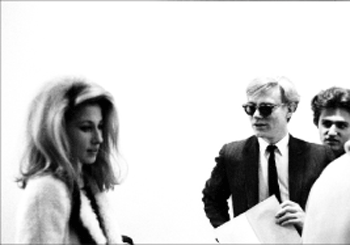Andy Warhol’s four hours of fame
Andy Warhol lined Marilyn Monroe’s eyelids in baby blue, her lips in vivid tangerine, over and over again, one Marilyn after another—in serial permutation—for emphasis.
The emphasis of Ric Burns’ four-hour “Andy Warhol: A Documentary Film” seems to be how Andy repeatedly seized on the death of somebody famous to make himself famous.
Near the middle of the four-hour documentary there is even a shot of him standing beside an enormous black-and-white rendering of a skull, his reality-shock array of “Death and Disaster” news photos of automobile accidents he made after the death of his mother in 1972.
Even when he turned his silk screens over to somebody famous and alive—Elizabeth Taylor, for instance—it was, as he says in the movie, “to rescue her from the garbage can.”
It may be a libel to maintain that when the dancer Fred Herko danced out of a Cornelia Street window to his death in 1964, Warhol said, “I’m sorry I wasn’t there to shoot it,” but it’s not unbelievable.
It’s a matter of record what happened to more than one of the Andy Warhol Superstars when the glitter and the glory wore off, particularly to the beautiful and screwed-up Edie Sedgwick, who died at 28 without Andy lifting a finger to save her. Andy primarily existed, as a disenchanted acolyte attests, “to make the world safe for Andy.”
Sedgwick and Warhol’s mother Julia Warhola represent opposite poles of Burns’ examination of the artist’s life and times.
One can’t help sort of falling in love with Warhola, the “strong-willed, idiosyncratic,” tight-faced, churchgoing, God-fearing working-class Polish-American widow who cleaned houses for $1 a day and saved tinfoil to sell to neighbors when Andy was growing up on the wrong side of the tracks during the Depression.
The woman who also refused all her life to face up to the basics of an “excruciatingly shy” son who, when the other kids were out playing baseball, would sit at home drawing butterflies and flowers; a child whose rheumatic fever paved the way for St. Vitus’ Dance, a tremor of the nerves that made Warhol the object of ridicule whenever he had to go to the blackboard. A youth prey to “13 nervous breakdowns in his first 13 years,” in the words of George Plimpton. It helps explain the numbed-out features, the poker face, the toneless uninflected voice, the keep-the-world-out dark shades, the ever more grotesque wigs throughout later life.
Where did it come from, this enormous fecund tide of drawings, paintings, silk screens, photographs, Brillo boxes, Coke bottles, Campbell’s Soup cans, dollar bills, Marilyns, Jackies, Lizzes, Marlons, not to mention “Kiss,” “Sleep,” “Blow Job,” “Empire State,” “Chelsea Girls,” and several dozen other films?
First, manifestly, unarguably, it came from talent—a clear-cut, uncomplicated, commercial talent for drawing. It is art curator Donna De Salvo who in the documentary underscores how Andy in the bare lines of, say, a Coke bottle, eliminated brushwork, shading, shadows, all those messy encroachments to produce “very radical, in-your-face” paintings “that were essentially non-paintings.”
Second was a keen, never-fogging eye for opportunity—Warhol, the Jay Gatsby of modern art, collecting around him, like a magnet, without really trying.
The third driving force—simple envy. In the field of art there was not only Picasso bestride the world like a Colossus, but, coming up fast on the inside track, Jasper Johns, Rauschenberg, Frank Stella & Co., the nuts-and-bolts murderers of Abstractionism. In the literary world there was Truman Capote, who looked like Warhol wanted to look. The young Andy not only besieged Capote with fan letters and telephone calls, but according to the film, he also began to stalk him. Plimpton, more dry and detached than most of the talking heads in this production, remembers how Capote considered the 1950s Warhol “just a window-dresser, a hopeless born loser.”
A four-hour documentary needs the talking heads as support pillars. Those here range from the sourly objective Ronald Tavel, screenwriter of many of Andy’s films, to the worshipful, true-believing dealer/collector Irving Blum, to the modest, no-nonsense John Warhola, Andy’s brother. Central to everything is Warhol’s one-time chief-cook-and-bottle- washer Billy Name, long of beard and forehead now as then, except the black beard is now straggly gray-white. Another prime source is Paul Morrissey, Warhol’s onetime manager and filmmaker.
Each subject contributes intelligent nuggets, but when their identifying subtitle disappears, one’s memory of who said what also vanishes. A good third of these talkers put the advent of Andy Warhol on par with the advent of Jesus Christ. “Picasso owns the first half of the 20th century,” says one magpie, “and Andy owns the second half.” Uh-huh.
Does “Andy Warhol: A Documentary Film” teach us anything new? Not really. What it does well, if a little exhaustively, is recapitulate. And it also provides at least two examples of Warhol’s silent, waspy sense of humor. One, when he sent a doppelgänger out to a speaking engagement in Wisconsin, and two, when, he proposed a wall of the FBI’s 10 Most Wanted for a mural at the 1964 New York World’s Fair; when that was turned down, he offered instead a giant portrait of Robert Moses.
Shrewdly, Burns opens and closes his film with SoHo gallery pioneer Ivan C. Karp, one of the heralds of latter-day American art, asking Warhol, why this endless repetition, all that stuff in serial. “Why not something new?” To which Warhol responds flatly, tonelessly—“Because it’s easier to do.”
gaycitynews.com



































